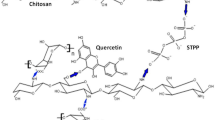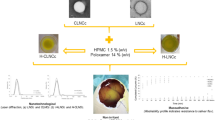Abstract
The current research aims to develop and evaluate chitosan-PLGA biocomposite scaffolds in combination with quercetin liposomes to accomplish the desired impact in oral lesions where pharmacotherapeutic agent treatment through circulation could only reach the low content at the target. Optimization of quercetin-loaded liposomes was carried out using 32 factorial design. The preparation of porous scaffolds comprising produced quercetin-loaded liposomes by thin-film method was carried out in the current study using a unique strategy combining solvent casting and gas foaming procedures. The prepared scaffolds were tested for physicochemical properties, in vitro quercetin release study, ex vivo drug permeation and retention research using goat mucosa, antibacterial activity, and cell migration studies on fibroblast L929 cell lines. Improved cell growth and migration were seen in the order control < liposomes < proposed system. The proposed system has been examined for its biological and physicochemical features, and it has the potential to be utilized as an efficient therapy for oral lesions.
Graphical abstract







Similar content being viewed by others
Data Availability
Data sharing is not applicable to this article as no datasets were generated or analyzed during the current study.
Change history
17 August 2023
A Correction to this paper has been published: https://doi.org/10.1208/s12249-023-02636-2
References
Akash MS, Rehman K, Chen S. Polymeric-based particulate systems for delivery of therapeutic proteins. Pharm Dev Technol. 2016;21(3):367–78.
Amirchaghmaghi M, Delavarian Z, Iranshahi M, Shakeri MT, Mozafari PM, Mohammadpour AH, Farazi F, Iranshahy M. A randomized placebo-controlled double blind clinical trial of for treatment of oral lichen planus. J Dent Res Dent Clin Dent Prospects. 2015;9(1):23.
Attia DA, El-Say KM, Ramadan AA. Optimization and characterization of bioadhesive gastroretentive amoxicillin tablets using the mixture experimental design. J Appl Sci. 2008;4(11):1328–39.
Avachat AM, Gujar KN, Wagh KV. Development and evaluation of tamarind seed xyloglucan-based mucoadhesive buccal films of rizatriptan benzoate. Carbohydr Polym. 2013;91(2):537–42.
Bangham AD, Standish MM, Watkins JC. Diffussion of univalent ion across the lamellae of swollen phospholipids. J Mol Biol. 1995;13:238–52.
Begum MYM, Osmani RA, Alqahtani A, Ghazwani M, Hani U, Ather H, Rahamathulla M, Siddiqua A. Development of stealth liposomal formulation of celecoxib: In-vitro and In-vivo evaluation. Plos One. 2022;17(4):e0264518.
Cascone MG, Barbani N, Cristallini C, Giusti P, Ciardelli G, Lazzeri L. Bioartificial polymeric materials based on polysaccharides. J Biomater Sci Polym Ed. 2001;12:267–81.
Chang JS, Chang KL, Hwang DF, Kong ZL. In-vitro cytotoxicitiy of silica nanoparticles at high concentrations strongly depends on the metabolic activity type of the cell line. Environ Sci Technol. 2007;41(6):2064–8.
Chen G, Kawazoe N, 3.1 - Preparation of polymer scaffolds by ice particulate method for tissue engineering, Editor(s): Mitsuhiro Ebara, Biomaterials Nanoarchitectonics, William Andrew Publishing, 2016, Pages 77-95, ISBN 9780323371278, https://doi.org/10.1016/B978-0-323-37127-8.00006-6.
Coondoo A, Phiske M, Verma S, Lahiri K. Side-effects of topical steroids: a long overdue revisit. Indian Dermatol Online J. 2014;5(4):416–25.
Dash S, Murthy PN, Nath L, Chowdhury P. Kinetic modeling on drug release from controlled drug delivery systems. Acta Pol Pharm. 2010;67(3):217–23.
Devi M, Kumar MS, Mahadevan N. Amphotericin-B loaded vesicular systems for the treatment of topical fungal infection. Int J Rec Adv Pharm Res. 2011;4:37–46.
Dhandayuthapani B, Yoshida Y, Maekawa T, Kumar DS. 2011. Polymeric scaffolds in tissue engineering application: a review. Int J Polym Sci. 290602. https://doi.org/10.1155/2011/290602.
Doijad RC, Manvi FV, Rao VM, Patel PS. Buccoadhesive drug delivery system of isosorbide dinitrate: formulation and evaluation. Indian J Pharm Sci. 2006;68(6):744.
Erjavec V, Pavlica Z, Sentjurc M, Petelin M. In vivo study of liposomes as drug carriers to oral mucosa using EPR oximetry. Int J Pharm. 2006;307(1):1–8.
Evans ND, Gentleman E, Polak JM. Scaffolds for stem cells. Mater Today. 2006;9(12):26–33.
Garg T, Singh O, Arora S, Murthy RS. Scaffold: a novel carrier for cell and drug delivery. Crit Rev Ther Drug Carrier Sys. 2012;29(1):1–63.
Gubernator J. Active methods of drug loading into liposomes: recent strategies for stable drug entrapment and increased in vivo activity. Expert Opin Drug Deliv. 2011;8(5):565–80.
Gupta V, Barupal AK, Ramteke S. Formulation development and In-vitro characterization of proliposomes for topical delivery of aceclofenac. Indian J Pharm Sci. 2008;70(6):768.
Hamdy AA, Ibrahem MA. Management of aphthous ulceration with topical quercetin: a randomized clinical trial. J Contemp Dent Prac. 2010;11(4):E009–16.
Hokmabad VR, Davaran S, Aghazadeh M, Rahbarghazi R, Salehi R, Ramazani A. Fabrication and characterization of novel ethyl cellulose-grafted-poly (ɛ-caprolactone)/alginate nanofibrous/macroporous scaffolds incorporated with nano-hydroxyapatite for bone tissue engineering. J Biomater Appl. 2019;33(8):1128–44.
Hamid AMS, Rehman K, Chen S. Natural and synthetic polymers as drug carriers for delivery of therapeutic proteins. Polym Rev. 2015;55(3):371–406.
Kao TK, Ou YC, Raung SL, Lai CY, Liao SL, Chen CJ. Inhibition of nitric oxide production by quercetin in endotoxin/cytokine-stimulated microglia. Life Sci. 2010;86(9-10):315–21.
Kaur A, Kaur G. Mucoadhesive buccal patches based on interpolymer complexes of chitosan–pectin for delivery of carvedilol. Saudi Pharm J. 2012;20(1):21–7.
Lee EJ, Kasper FK, Mikos AG. Biomaterials for tissue engineering. Ann Biomed Eng. 2014;42(2):323-337. doi: 10.1007/s10439-013-0859-6
Khojasteh A, Motamedian SR, Rad MR, Shahriari MH, Nadjmi N. Polymeric vs hydroxyapatite-based scaffolds on dental pulp stem cell proliferation and differentiation. World J Stem Cells. 2015;7(10):1215.
Jithendra PAM, Rajam T, Kalaivani AB, Mandal RC. Preparation and characterization of aloe vera blended collagen-chitosan composite scaffold for tissue engineering applications. ACS Appl Mater Interfaces. 2013;5(15):7291–308.
Lakhanpal P, Rai DK. Quercetin: a versatile flavonoid. Internet J Med Update. 2007;2(2):22–37.
Langer R, Acanti JP. Tissue engineering. Sci. 1993;260(5110):920–6.
Liang C-C, Park AY, Guan J-L. In-vitro scratch assay: a convenient and inexpensive method for analysis of cell migration In-vitro. Nat Protoc. 2007;2:329–33.
Lin YJ, Yen CN, Hu YC, Wu YC, Liao CJ, Chu IM. Chondrocytes culture in three-dimensional porous alginate scaffolds enhanced cell proliferation, matrix synthesis and gene expression. J Biomed Mater Res A. 2009;88(1):23–33.
Ma L, Gao C, Mao Z, Zhou J, Shen J, Hu X, Han C. Collagen/chitosan porous scaffolds with improved biostability for skin tissue engineering. Biomaterials. 2003;24(26):4833–41.
Maherani B, Arab-Tehrany ER, Mozafari M, Gaiani C, Linder M. Liposomes: a review of manufacturing techniques and targeting strategies. Curr Nanosci. 2011;7(3):436–52.
Mandal BB, Kundu SC. Cell proliferation and migration in silk fibroin 3D scaffolds. Biomaterials. 2009;30(15):2956–65.
Meng ZX, Zheng W, Zheng W, Li L, Li L, Zheng Y, Zheng Y. Fabrication, characterization and in vitro drug release behavior of electrospun PLGA/chitosan nanofibrous scaffold. Mat Chem Phy. 2011;125(3):606–11.
Mostafa MA, Ibrahem MA. Management of aphthous ulceration with topical quercetin. Cairo Dent J. 2009;25(1):15.
Munot N, Kandekar U, Rikame C, Patil A, Sengupta P, Urooj S, Bilal A. Improved mucoadhesion, permeation and in-vitro anticancer potential of synthesized thiolated Acacia and Karaya gum combination: a systematic study. Molecules. 2022b;27(20):6829.
Munot N, Kandekar U, Giram PS, Khot K, Patil A, Cavalu S. A comparative study of quercetin-loaded nanocochleates and liposomes: formulation, characterization, assessment of degradation and in-vitro anticancer potential. Pharmaceutics. 2022a;14(8):1601.
Nguyen TLA, Bhattacharya D. Antimicrobial activity of quercetin: an approach to its mechanistic principle. Molecules. 2022;27(8):2494.
Paderni C, Compilato D, Giannola LI, Campisi G. Oral local drug delivery and new perspectives in oral drug formulation. Oral Surg. Oral Med. Oral Pathol. Oral Radiol. 2012;114(3):e25–34.
Pan Z, Ding J. Poly(lactide-co-glycolide) porous scaffolds for tissue engineering and regenerative medicine. Interface Focus. 2012;2(3):366–77.
Patel V, Liu F, Brown MB. Advances in oral transmucosal drug delivery. J. Control Release. 2011;153(2):106–16.
Patel VF, Liu F, Brown MB. Modeling the oral cavity: in-vitro and in vivo evaluations of buccal drug delivery systems. J Control Release. 2012;161(3):746–56.
Patil PS, Salunkhe VR, Bhinge SD, Patil SB, Kumbhar BV. Formulation optimization and evaluation of glycyrrhetinic acid loaded PLARosome using factorial design: in-vitro anti-ulcer activity and in silico PASS prediction. J Indian Chem Soc. 2021;98:100199.
Patil A, Munot N, Patwekar M, Patwekar F, Ahmad I, Alraey Y, Alghamdi S, Kabrah A, Dablool AS, Islam F. Encapsulation of lactic acid bacteria by lyophilisation with its effects on viability and adhesion properties. Evid Based Complement Altern Med. 2022;4651194:9.
Pawar A, Bothiraja C, Shaikh K, Mali A. An insight into cochleates, a potential drug delivery system. RSC Adv. 2015;5(99):81188–202.
Peter M, Ganesh N, Selvamurugan N, Nair SV, Furuike T, Tamura H, Jayakumar R. Preparation and characterization of chitosan–gelatin/nanohydroxyapatite composite scaffolds for tissue engineering applications. Carbohydr Polym. 2010;80(3):687–94.
Salunkhe VR, Patil PS, Wadkar GH, Bhinge SD. Herbal liposomes: natural network for targeted drug delivery system. Int J Pharm Res. 2021;33(29B):31–41.
Sarkar N, Bose S. Liposome-encapsulated curcumin-loaded 3D printed scaffold for bone tissue engineering. ACS Appl Mater Interfaces. 2019;11(19):17184–92.
Shirvan AR, Bashari A, Hemmatinejad. New insight into the fabrication of smart mucoadhesive buccal patches as a novel controlled-drug delivery system. Eur Polym J. 2019;119:541–50.
Vissers CA, Harvestine JN, Leach JK. Pore size regulates mesenchymal stem cell response to Bioglass-loaded composite scaffolds. J Mat Chem B. 2015;3(44):8650–8.
Yardimci G, Kutlubay Z, Engin B, Tuzun Y. Precancerous lesions of oral mucosa. World J Clin Cases. 2014;2(12):866–72.
Yu ES, Min HJ, An SY, Won HY, Hong JH, Hwang ES. Regulatory mechanisms of IL-2 and IFNγ suppression by quercetin in T helper cells. Biochem Pharmacol. 2008;76(1):70–88.
Wijetunge SS, Wen J, Yeh CK, Sun Y. Lectin-conjugated liposomes as biocompatible, bioadhesive drug carriers for the management of oral ulcerative lesions. ACS Appl Bio Mater. 2018;1(5):1487–895.
Zakizadeh M, Nabavi SF, Nabavi SM, Ebrahimzadeh MA. In-vitro antioxidant activity of flower, seed and leaves of Alcea hyrcana Grossh. Eur Rev Med Pharmacol Sci. 2011;15(4):406–12.
Zhang H, Liu X, Yang M, Zhu L. Silk fibroin/sodium alginate composite nano-fibrous scaffold prepared through thermally induced phase-separation (TIPS) method for biomedical applications. Mat Sci Eng C. 2015;55:8–13.
Zhang J, Liu H, Ding JX, Wu J, Zhuang XL, Chen XS, Wang JC, Yin JB, Li ZM. High-pressure compression-molded porous resorbable polymer/hydroxyapatite composite scaffold for cranial bone regeneration. ACS Biomater Sci Eng. 2016a;2(9):1471–82.
Zhang J, Yang SG, Ding JX, Li ZM. Tailor-made poly (l-lactide)/poly (lactide-co-glycolide)/hydroxyapatite composite scaffolds prepared via high-pressure compression molding/salt leaching. RSC Adv. 2016b;6(53):47418–26.
Zhu CT, Xu YQ, Shi J, Li J, Ding J. Liposome combined porous β-TCP scaffold: preparation, characterization, and anti-biofilm activity. Drug Deliv. 2010;17(6):391–8.
Funding
This study was funded by Savitribai Phule Pune University under Aspire Research Mentorship Grant (Grant No. 18TEC001157).
Author information
Authors and Affiliations
Contributions
All authors contributed to the study’s conception and design. The first draft of the manuscript was written by Neha Munot, and all authors commented on previous versions of the manuscript. All authors read and approved the final manuscript.
Corresponding author
Ethics declarations
Ethics Approval and Consent to Participate
Not applicable
Consent for Publication
Not applicable.
Competing Interests
The authors declare no competing interests.
Additional information
Publisher’s Note
Springer Nature remains neutral with regard to jurisdictional claims in published maps and institutional affiliations.
Highlights
• In this research, the authors have successfully prepared porous biocomposite scaffolds loaded with quercetin liposomes.
• Liposomes is novel drug delivery system to achieve target-specific action along with other numerous benefits than conventional drug delivery system.
• Moreover, authors have successfully characterized prepared porous biocomposite scaffolds loaded with quercetin liposomes using advanced tools.
• The authors have explored the improved healing of oral lesions and antibacterial activity of porous biocomposite scaffolds loaded with quercetin liposomes.
The original article has been updated to correct Dr. Pranav Shah's affiliation.
Rights and permissions
Springer Nature or its licensor (e.g. a society or other partner) holds exclusive rights to this article under a publishing agreement with the author(s) or other rightsholder(s); author self-archiving of the accepted manuscript version of this article is solely governed by the terms of such publishing agreement and applicable law.
About this article
Cite this article
Munot, N.M., Shinde, Y.D., Shah, P. et al. Formulation and Evaluation of Chitosan-PLGA Biocomposite Scaffolds Incorporated with Quercetin Liposomes Made by QbD Approach for Improved Healing of Oral Lesions. AAPS PharmSciTech 24, 147 (2023). https://doi.org/10.1208/s12249-023-02584-x
Received:
Accepted:
Published:
DOI: https://doi.org/10.1208/s12249-023-02584-x




